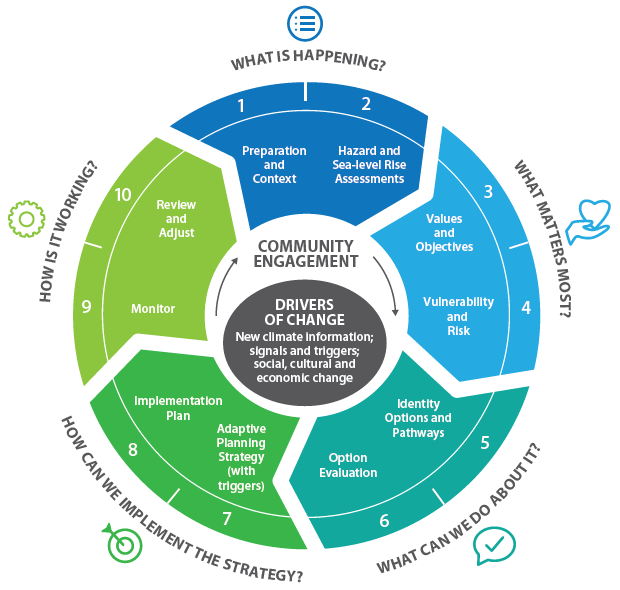"Dynamic adaptive pathways planning"
The guidance
As set out in the Introduction, in 2017 the MfE published guidance for local government which provided direction on the coastal adaptation planning process and recommended five stages and 10 steps to achieve this (see figure below). The approach adopted for this project has strongly aligned with this process and with the guidance. The project concluded at the end of Step 7 (the development of adaptive planning strategies, i.e., CAPs). The next step for TCDC is Step 8 – implementation (see "Next Steps").

The “essence” of the process
Values → Hazards → Risk → Tolerability → Adaptive Pathways
The process adopted for the project required coastal hazards and community values to be understood, and (tolerable and intolerable) risks to be defined, to determine how to manage these risks through the selection of appropriate adaptation strategies (see "What can we do about it?"). Because coastal hazard risk is predicted to change over time, suitable adaptation options may also need to change – which means that the adaptation strategy for any one location needs to take the form of a ‘pathway’ that starts with short term actions and, if and when change occurs, moves to new actions (see "How do we get it done?"). The pathways need to be flexible (i.e., dynamic) – so they can be modified, if required, over time if ‘triggers for action’ are reached or if community values change.
Importantly, given the uncertainty associated with the changes that will occur, decisions to act based on triggers being met will be taken based on monitoring results (real data) and not predictions or modelled data.
Community led
The project was ‘community led’ and this principle was at the core of the process adopted by TCDC. The pathways were developed by the project team working with nominated representatives of the community (Coastal Panels, see "Community led"), rather than elected officials, and drawing on feedback received from the wider community. The emphasis of the Government’s National Adaptation Plan (MfE, 2022)[1] is on empowering local communities to define and determine how best to manage the risks associated with climate change, a concept inherent in TCDC’s approach.
Footnotes
- 1 MfE (2022). Aotearoa New Zealand’s first national adaptation plan. Wellington. Ministry for the Environment. August 2022.